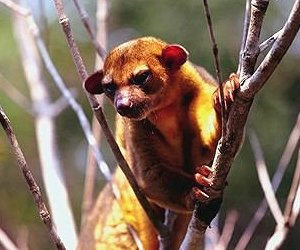
More about Kinkajou
Habitat
The kinkajou lives in the canopy of several stages of forest, including mature, disturbed, and secondary rainforest; they may also be found in gallery forest, deciduous forest, and sometimes gardens and plantations.
Range
This mammal lives from Veracruz, Mexico to Mato Grosso, Brazil; it is rarely above 500 m, but may reach 1,750 m in elevation.
Physical Description
Reddish to smoky gray-brown, this monkey-like animal often has a dark brown stripe on its back. Its underside is yellow to pale orange. Their bodies are covered in dense, soft, short fur. The round head and face are red-brown to black with a short pointed muzzle. Kinkajous have large, round, brown eyes set far apart; in the moonlight (or the beam of a flashlight), their eyeshine is yellow-white to greenish white. They have a long, extensible tongue that is dark at the tip.
The kinkajou has long curved claws that help it live arboreally high up in the canopy. It is extremely agile and muscular, but surprisingly short-legged for their movements. It has a long back and a distinct prehensile, tapered tail that it usually keeps curled around a branch while moving or feeding. This animal is noisy as it runs and jumps from tree to tree at night.
Olingos look similar to kinkajous, but they can be told apart because the olingo is smaller, has a nonprehensile tail with a bushy tip, and at night the olingo's belly looks dark, whereas the kinkajou's looks pale.
Biology and Natural History
Widespread and common, the kinkajou persists although it is hunted for meat and the pet trade.
Kinkajous often live solitarily, or in pairs, but several kinkajous may feed in a tree at one time at night; during the day they sleep in tree hollows. Several males may have large ranges that overlap a female's smaller range. She will have one baby at a time, and they will keep their bond for a while. Kinkajous are highly vocal, using sneezing whistles and other sounds.
Diet
This mammal mostly eats fruits, especially figs, as well as insects, especially ants; it may also eat arboreal vertebrates. In the dry season it drinks flower nectar. This species is an important disperser of Ficus spp., Virola spp., and Inga spp.
Height/Weight
The head and body length is 0.5 m; tail length 0.45 m; they weight about 3 kg.
Taxonomy
Order: Carnivora
Family: Procyonidae
Sources
Eisenberg, John. Mammals of the Neotropics, Vol. 1. The University of Chicago Press: Chicago, 1989.
Emmons, Louise H. Neotropical Rainforest Mammals: A Field Guide, 2nd Ed. University of Chicago Press: Chicago, 1990.
Wilson, D. E. in Janzen, Daniel H. Costa Rican Natural History. Chicago: University of Chicago Press, 1983.
-Amy Strieter, Wildlife Writer
Kinkajou Sightings
Similar Profiles
We believe travel is more than ticking destinations off a list – it’s about discovering new places deeply, feeling connected wherever you go, and knowing you have a trusted team behind you every step of the way.



